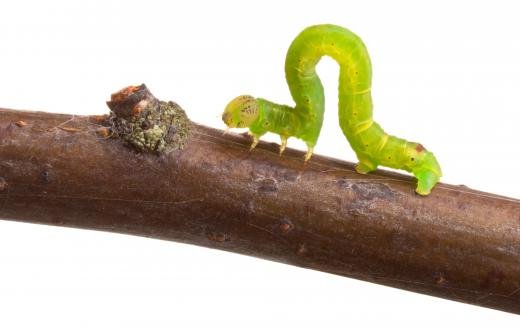
Inchworms, which are actually the larvae of moths from the Geometridae family, come in a range of colors and sizes. They can be found in various ecosystems, from lush forests to grasslands. But the bigger question is, can they be found everywhere across the globe? Let’s take a closer look and explore their distribution and some interesting facts along the way.
What Are Inchworms Anyway?
Before diving into their global presence, it’s essential to understand what inchworms are. **Inchworms** are the larval stage of geometrid moths. They get their name from their unique way of moving—contracting and stretching their bodies as if they’re measuring the ground in inches! This peculiar movement often makes them look like they’re inching along, rather than crawling like typical caterpillars.
Inchworms have a soft, elongated body with two or three pairs of true legs. But they also have a few extra “false legs” at the back, which they use for gripping onto surfaces. This design helps them camouflage in their surroundings, making them harder for predators to spot. Picture them blending in with the leaves and twigs—nature’s little escape artists!
You might catch a glimpse of them during spring and summer, as they often emerge when the weather warms up. They feed on various plants, including trees, shrubs, and meadows, making them a common sight in gardens and forests alike. But now that we know a bit about these little guys, let’s explore their global distribution.
Inchworm Distribution: A Global Overview
Now, back to our original question: Are inchworms found on every continent? The short answer is not exactly. Inchworms are primarily found in temperate and tropical regions, but their distribution varies from continent to continent.
– **North America:** Inchworms are quite common here. They thrive in forests and gardens, where they can munch on a variety of plants. During certain seasons, you might find them in abundance, especially in areas with rich vegetation.
– **Europe:** Just like in North America, inchworms are prevalent in Europe. From the lush woodlands of the British Isles to the vast forests of Eastern Europe, these little creatures make their homes among the trees.
– **Asia:** Asia hosts many species of inchworms as well. Countries like Japan and China have specific species suited to their local environments.
However, the presence of inchworms diminishes in certain areas. For instance, in colder regions or those with extreme climates, you’re less likely to find them.
Where Are Inchworms Absent?
While inchworms are widespread, there are areas where you won’t find them. One notable absence is in polar regions, such as Antarctica. The extreme cold and lack of suitable vegetation make it impossible for these creatures to survive.
Likewise, **desert regions** are also less hospitable to inchworms. These areas often lack the moisture and plant life they need for feeding and reproduction. Without a consistent food source, inchworms would struggle to find sustenance and thrive.
Even in some islands, like those in the Pacific, inchworms might be scarce. Islands with fewer plant species can limit where they can establish their populations.
The Role of Climate in Inchworm Presence
You might be wondering why inchworms are so closely tied to specific climates. Here’s the thing: Climate plays a significant role in shaping the habitats where inchworms thrive. They prefer environments that offer moderate temperatures and plenty of moisture.
In **temperate regions**, the changing seasons provide the right conditions for these larvae. Spring and summer bring warmth and a burst of plant growth, giving inchworms a chance to feed and develop into moths. Conversely, in **tropical regions**, the consistent warm temperatures and abundant plant life allow for a year-round presence.
However, in places like the Arctic or deserts, the harsh conditions simply don’t match their needs. The lack of food sources and suitable weather limits their survival.
Inchworms and Ecosystems
Inchworms play a crucial role in their ecosystems. They act as **herbivores**, feeding on plant leaves and helping to control plant populations. This feeding habit makes them essential for maintaining the balance in ecosystems—preventing certain plants from overtaking areas while allowing diversity to thrive.
Additionally, inchworms serve as a food source for various predators. Birds, small mammals, and even other insects rely on them for nourishment. Their presence in the food chain supports the health of the broader ecosystem.
Interestingly, inchworms also have a unique way of contributing to the environment. When they go through their life cycle, they eventually become moths that participate in pollination. This process is vital for many plants and contributes to biodiversity.
Fun Facts About Inchworms
Inching along might not seem like much of a talent, but inchworms have some cool characteristics that are worth mentioning. Here are a few fun facts:
- Color Variation: Inchworms can be green, brown, or even beige, helping them blend into their surroundings.
- Camouflage Skills: Their body shapes and colors allow them to mimic twigs or leaves, making it hard for predators to spot them.
- Short Life Cycle: They don’t stay in the inchworm stage for long. After about four to six weeks, they pupate and turn into adult moths.
- Adaptability: Inchworms can adapt to various plants, which helps them thrive in different environments.
These little facts highlight just how intriguing inchworms are, showcasing their adaptability and role in nature.
So, are inchworms found on every continent? Not quite, but they do make their homes in many temperate and tropical regions. While they thrive in places like North America, Europe, and parts of Asia, they’re absent in extreme climates like the polar regions and deserts.
Their presence is tied closely to the right conditions—moderate temperatures, moisture, and ample plant life. Understanding where inchworms live helps us appreciate their role in ecosystems and the beauty of biodiversity.
Next time you spot an inchworm inching along a branch, take a moment to appreciate this little creature. It’s more than just a cute critter—it’s a vital part of the web of life that connects us all.
